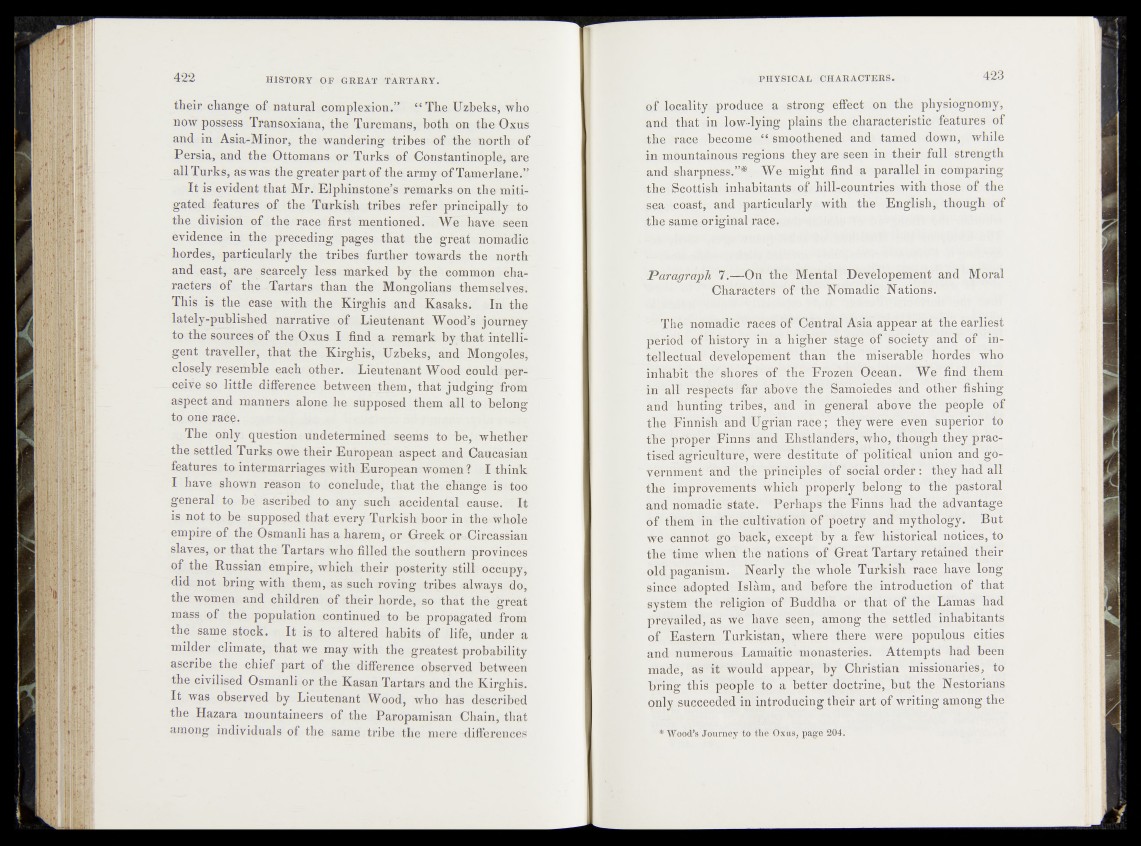
their change of natural complexion.?- “ Th%Uzbeks, who
now possess Transoxiana, the Turcmans, both on the Oxus
and in Asia-Minor, the wandering tribes of the north of
Persia, and the Ottomans or Turks of Constantinople, are
all Turks, as was the greater part of the army of Tamerlane.?
It is evident that Mr.Elphinstone’s remarks on the mitigated
features of the Turkish tribes refer principally to
the division of the race first mentioned* We have seen
evidence in the preceding pages that the great nomadic
hordes, particularly the tribes further towards the north
and east, are scarcely less marked by the common characters
of the Tartars than the Mongolians themselves i
This is the case with the Kirghis and Kasaks. In the
lately-published narrative of Lieutenant Wood’s journey
to the sources of the Oxus I find a remark by that intelligent
traveller, that the Kirghis, Uzbeks, and Mongofesj
closely resemble each other. Lieutenant Wood could .perr
ceive so little difference between them, that judging (from
aspect and manners alone he supposed them all to belong
to one race,
The only question undetermined seems to be, whether
the settled Turks owe their European aspect and Caucasian
features to intermarriages with European women ? I think
I have shown reason to conclude, that the change ife too
general to be ascribed to any such accidental cause. It
is not to be supposed that every Turkish boor in the whole
empire of the .Osmanli has a harem, or Greek or-Circassian
slaves, or that the Tartars who filled the southern provinces
of the Russian empire, which their posterity still occupy,
did not bring with them, as such roving tribes always do,
the women and children of their horde, so that the great
mass of the population continued to be propagated from
the same stock. It is to altered habits of life, under a
milder climate, that we may with the greatest probability
ascribe the chief part of the difference observed between
the civilised Osmanli or the Kasan Tartars and the Kirghis.
It was observed by Lieutenant Wood, who has described
the Hazara mountaineers of the Paropamisan Chain, that
among individuals of the same tribe the mere differences
qf .lo,c'al%>*pr©dsu@e a stroitg effect on the physiognomy,
and that 4n 4o$v-lying plains *the. characteristic features of
fibhe■!race ‘be-pOpae “ sm©J>!he’ned and tamed down, while
mountainous; regions they ai?e>seen in their full strength
and sharpn;esslr!%- We might find a paral&el|®6 comparing
foW Sff'otif.ij^ mhabitants. of hil^eountries with these of the
;pe,a_^coast, and particularlyu with; the* «English, though of
the same-original race^f.
Paragraph 7.—Off the'Metttal Dbvpfopement and Moral
Characters ‘of the' Nomadlh;^Natipqf
The nomadic'-ra'ces b'f Central Asia ajjpear at^me iarlfest
period of y iPa? ^fpbMy and
fblllfctual dfvblopethehl;' thair me ' miseihbl^Pordes who
inbablf^tH^&hore#*of!f1:hl‘ Frozbn Ocean 1 We find them
U all respects far above th^^^Shi^Mes^nd^^pfmshin^
ani^hunfmg Mwf, ‘and in general abov^e ihe people of
the Finlii$hrtand Ugri^'rice ;''4hly>werefmven Superior to
the proper 'Finns and Ehstlandfffcfwho, though they'practise#
agricultu re\#eife' desnrare ‘p d fi^ ^ r union and
vernmen#fand the principTes^o^o^I^rder r/wey hdd all
the? improvements which* properly belbn^to the pastoral
and nomadic state. Perhaps the Finns 'had the hdvanfage
of theiff%i the cultivation b f poi'etry ahd m y th d |^ p But
we cannot go back, l&cJ^t by a few historical notices, to
the time whe# the nationS^of Great Tartary retained their
old paganism. Nearly the whole Turkish race hayg^ong,
since adopted Islam, and before thei introduction of that
system the religion of Buddha or that of the^Lainas had
prevailed, as we Have4 lejenT^amohg the*'se'iftled^ inhabitant
of Eastern Turkistan, where there were popu^ps cities
and numerous Lamaitic -monasteries^ Attempts had been
made, as it would appear, by'’ Christian missionaries, to
bring this people to a better doctrine, but the. Nestorians
only succeeded in introducing their art of writing among the
Wood’s Journey to the Oxus, page 204.